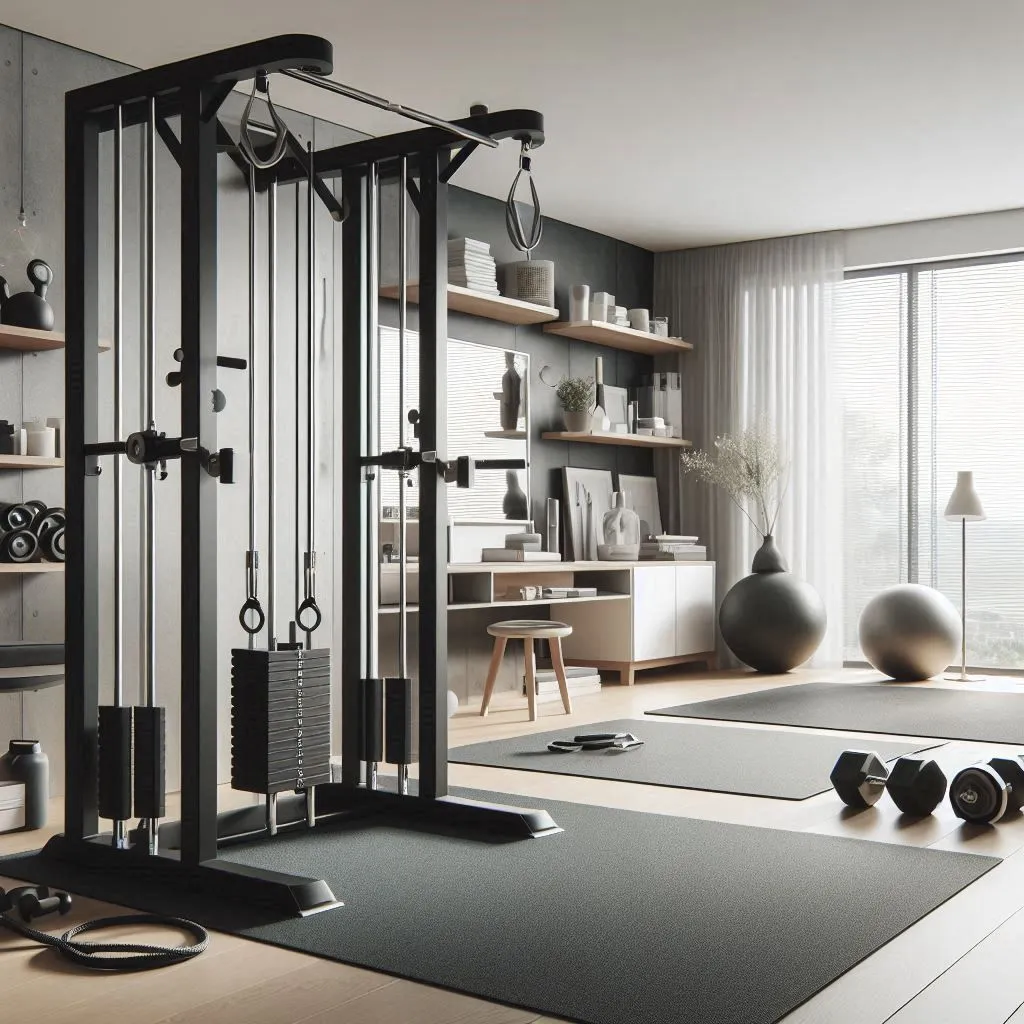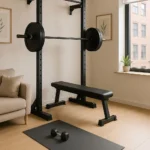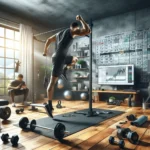Introduction: Transform Your Fitness Journey with a Home Gym Cable Machine
Are you tired of waiting for equipment at crowded gyms? Frustrated by commute times eating into your workout schedule? Imagine having the versatility of an entire gym’s worth of cable exercises right in your living room, available 24/7 without monthly membership fees or waiting for equipment.
Home gym cable machines represent one of the most versatile fitness investments you can make, offering incredible workout variety while taking up less space than a collection of specialized equipment. Whether you’re looking to build strength, increase muscle definition, improve functional fitness, or simply maintain your health, a quality cable machine can be the cornerstone of your home fitness setup.
By the end of this guide, you’ll understand why a home gym cable machine could revolutionize your fitness routine, how to select the perfect model for your space and goals, and how to maximize its benefits for comprehensive strength training that rivals any commercial gym experience.
We’ll cover everything from the various types of cable machines available, crucial space considerations, top-recommended models across different budgets, exercise possibilities, and essential maintenance tips to help you make an informed decision and get the most from your investment.
Table of Contents
What Makes Home Gym Cable Machines Essential Fitness Equipment?
Understanding Home Gym Cable Machines
Home gym cable machines operate on a simple yet ingenious principle: they use cables, pulleys, and weights to create smooth, consistent resistance throughout a full range of motion. Unlike traditional free weights that rely on gravity (creating variable resistance as leverage changes), cable machines maintain constant tension on your muscles from start to finish of each movement.
The basic components include:
- A sturdy frame or tower structure
- Weight stacks or plate-loading systems
- High-quality cables that run through pulley systems
- Adjustable pulleys that can be positioned at various heights
- Connection points for different handles and attachments
This system evolved from early pulley-based rehabilitation equipment used in physical therapy settings to the sophisticated multi-functional trainers we see today. The transition to home use accelerated in the 1980s and 1990s as manufacturers recognized the growing demand for commercial-quality equipment in residential settings.
The science behind cable training is compelling: the constant tension created by the pulley system means your muscles remain engaged throughout the entire movement pattern, eliminating the “resting points” that occur with free weights. This leads to greater time under tension—a key factor in muscle development—and allows for fluid, natural movement patterns that better mimic real-world activities.
Benefits of Investing in a Home Gym Cable Machine
Unmatched Exercise Versatility Perhaps the most compelling advantage of home gym cable machines is their remarkable versatility. With a single piece of equipment, you can perform hundreds of exercises targeting every major muscle group. By simply changing the pulley height, attachment, or body position, you can transition from chest presses to rows, lat pulldowns to bicep curls, or tricep extensions to leg exercises—all without purchasing additional equipment.
Full-Body Workout Potential Unlike specialized machines that may focus on just one muscle group, cable systems allow for complete upper body, lower body, and core training. This makes them ideal for circuit training, supersets, and comprehensive workout routines that improve overall functional fitness rather than isolated strength.
Safer Resistance Training Cable machines offer a significant safety advantage over free weights, especially for solo home workouts. The guided motion reduces the risk of dropping weights, while the smooth resistance minimizes joint strain that can occur with jerky movements. For beginners or those recovering from injuries, this controlled environment provides confidence while maintaining effectiveness.
Space Efficiency In home settings where space is premium, cable machines shine by replacing numerous pieces of equipment. A single functional trainer can effectively substitute for a bench press, shoulder press machine, lat pulldown, row machine, and numerous dumbbell exercises—all while occupying a footprint of approximately 4′ × 6′ in many models.
Cost-Effectiveness Over Time While the initial investment may seem substantial, when compared to ongoing gym membership costs (averaging $40-100 monthly), a home gym cable machine typically pays for itself within 1-3 years. Factor in the time savings from eliminated commutes and the extended lifespan of quality equipment (10+ years for premium models), and the value proposition becomes even more attractive.
Convenience and Accessibility The convenience factor cannot be overstated. Having 24/7 access to your equipment eliminates common barriers to consistent exercise, including weather, gym crowding, operating hours, or childcare needs. This accessibility dramatically increases workout adherence—the single most important factor in achieving fitness goals.
Customizable Resistance Modern home gym cable machines offer precise resistance adjustments that accommodate users from beginners to advanced athletes. Weight increments as small as 5 pounds allow for progressive overload—the gradual increase in resistance that drives strength gains and muscle development over time.
Types of Home Gym Cable Machines
Functional Trainers with Dual Adjustable Pulleys The gold standard for home gym cable machines, functional trainers feature two independent weight stacks and adjustable pulleys that can be positioned at multiple heights. This design allows for unilateral (one-sided) exercises, crossover movements, and nearly unlimited exercise variety. Models like the Life Fitness G7 or Inspire FT2 represent this category.
Cable Crossover Machines Focusing primarily on horizontal cable movements, these machines excel at chest exercises, lateral movements, and certain back exercises. They typically feature fixed high and low pulley positions rather than fully adjustable ones. While less versatile than functional trainers, they often provide more stability for heavier lifts.
Smith Machine/Cable Hybrids These combination units pair a Smith machine (a barbell fixed within steel rails) with cable pulleys, offering both guided barbell training and cable exercises. Models like the Marcy SM-4033 provide excellent value for those wanting both training modalities without space for separate machines.
Compact Wall-Mounted Options Perfect for smaller spaces, wall-mounted cable machines anchor to your wall studs and typically offer adjustable pulley positions with more limited weight capacities. The PRx Profile Rack with cable attachment exemplifies this space-saving approach while maintaining functionality.
Portable Cable Systems For ultimate space efficiency, portable options like the Tension Toner or MAXPRO SmartConnect offer cable resistance training that can be stored in a closet when not in use. While they lack the weight capacity and stability of permanent fixtures, they provide remarkable versatility for travelers or apartment dwellers with severe space constraints.
All-in-One Home Gym Systems Brands like Bowflex, Total Gym, and Body-Solid offer integrated systems that combine cable functions with other training modalities such as press arms, leg developers, and pull-up stations. These provide comprehensive workouts but may sacrifice some cable functionality compared to dedicated cable machines.
The price spectrum ranges from budget options under $500 (often with band resistance rather than weight stacks) to premium models exceeding $3,000 that rival commercial gym quality. The key differences typically involve weight capacity, construction quality, smoothness of operation, adjustment options, and included attachments.
How to Choose the Perfect Home Gym Cable Machine
Space Considerations for Your Home Gym Cable Setup
Before falling in love with any particular model, an honest assessment of your available space is essential. Most functional trainers require:
- Footprint: Typically 4’×6′ to 5’×7′ for the machine itself
- Workout Space: An additional 4-6 feet of clearance on all sides for proper exercise execution
- Ceiling Height: Minimum 7′ for most models, though 8’+ is recommended for overhead exercises
- Floor Support: Reinforced flooring or platforms for heavier models, especially on upper floors
For those with space limitations, consider:
- Corner-optimized designs that maximize otherwise unused space
- Wall-mounted systems that fold away when not in use
- Compact single-stack models with smaller footprints
- Multi-purpose room planning with movable furniture
Take precise measurements of your intended area, including ceiling height, doorway widths (for delivery), and power outlet locations. Many manufacturers provide dimension guides and planning templates to help visualize the machine in your space.
Key Features to Look For
Weight Stack Capacity and Increments For beginners, a 150-200 lb weight stack per side is typically sufficient, while intermediate to advanced lifters may require 200-300 lbs. More important than maximum weight is the incremental adjustment—look for systems offering 5-10 lb increments for precise progression.
Pulley Quality and Operation The pulley system directly impacts workout quality. Premium features include:
- Sealed ball bearings versus bushings for smoother operation
- Fiberglass-reinforced nylon or machined aluminum pulley wheels
- Multiple pulley positions (15+ adjustment points is excellent)
- Quick-change pulley adjustment mechanisms
Cable Durability Cables are the most frequently replaced components. Look for:
- Aircraft-grade cables (typically 2000 lb test strength or greater)
- Nylon coating for smoother operation and reduced wear
- Easily accessible replacement parts program
- Warranty coverage specific to cables (2+ years ideal)
Attachment Variety and Compatibility Most machines come with basic handles, but the attachment ecosystem determines your exercise variety:
- Standard connections (carabiners or snap hooks) allow for third-party attachments
- Included attachment package (more comprehensive in premium models)
- Specialized attachments like ankle cuffs, tricep ropes, or long bars
Adjustment Options and Range of Motion More adjustment points equal greater exercise variety:
- Vertical adjustment range (from floor level to overhead)
- Horizontal adjustments for width variations
- Cable travel distance (longer is better for full range exercises)
- Independent arm adjustments for asymmetrical setups
Frame Stability and Construction Quality construction directly impacts safety and longevity:
- Heavy-gauge steel construction (11-gauge or better for main components)
- Welded versus bolted construction at key stress points
- Powder-coated or corrosion-resistant finishes
- Wide base dimensions for stability during heavy use
Weight Ratio Systems Cable machines use pulley ratios that affect the effective resistance:
- 1:1 ratio means 100 lbs on the stack feels like 100 lbs at the handle (preferred by experienced lifters)
- 2:1 ratio means 100 lbs on the stack feels like 50 lbs at the handle (smoother for beginners but requires larger weight stacks for advanced training)
Budget Considerations
Entry-Level Options (Under $500) At this price point, expect:
- Resistance bands rather than weight stacks in many models
- Single-station designs with limited adjustment options
- Lighter weight capacities (typically under 150 lbs)
- Basic construction with fewer attachment options
- Examples: Fitness Reality X-Class, Valor Fitness BD-62
Mid-Range Models ($500-$1500) The value sweet spot for many home users, offering:
- Single or double weight stacks (150-200 lbs each)
- Multiple adjustment positions
- Reasonable construction quality with good stability
- Several included attachments
- 2-5 year warranties
- Examples: Body-Solid GDCC200, Powerline PCCO90X
Premium Home Options ($1500+) Commercial-grade machines adapted for home use, featuring:
- Heavy-duty construction approaching gym quality
- Dual weight stacks (200-300 lbs each)
- Extensive adjustment options (20+ positions)
- Smooth, precisely engineered pulley systems
- Comprehensive attachment packages
- Extended warranties (often lifetime on frames)
- Examples: Life Fitness G7, Inspire FT2, Force USA G12
When budgeting, consider financing options (many manufacturers offer 0% plans) and the used market. When buying used, prioritize inspecting the cable condition, testing the pulley smoothness, and verifying all adjustment mechanisms function properly.
Top Home Gym Cable Machines for Every Space and Budget
Best Overall Home Gym Cable Machines
Premium Pick: Life Fitness G7 Home Gym with Bench The G7 represents commercial-quality engineering for home use, featuring:
- Dual 160 lb weight stacks with 2:1 ratio (effectively 80 lbs per side)
- Exceptionally smooth pulley operation with 20 adjustment positions
- Premium construction with commercial-grade components
- Comprehensive attachment package and accessory storage
- Industry-leading warranty coverage
- Optional bench with leg developer for expanded exercise options
Best Value: REP Fitness FT-3000 Functional Trainer ($1,700-2,000) Offering nearly commercial quality at a more accessible price point:
- Dual 220 lb weight stacks with 2:1 ratio
- 16 adjustment positions per column
- Multi-grip pull-up bar integrated
- Included accessory package with common attachments
- 10-year frame warranty
- Excellent balance of quality and affordability
Budget-Friendly: Fitness Reality 2366 X-Class Proving that effective cable training doesn’t require breaking the bank:
- Single 150 lb weight stack with dual pulley system
- 19 adjustment positions
- Smaller footprint (48″ W × 43.5″ D)
- Basic attachment package
- Solid construction despite lower price point
Wall-Mounted Champion: PRx Performance Profile Rack with Cable System
- Folds to just 4″ from wall when not in use
- Integrated power rack and cable system
- 250 lb weight capacity
- Requires just 4′ of floor space when extended
- Perfect for garage gyms and multi-purpose spaces
Apartment-Friendly: MAXPRO SmartConnect
- Portable cable machine weighing just 9 lbs
- Up to 300 lbs of resistance using magnetic technology
- Can be mounted to door or used freestanding
- Bluetooth connectivity for workout tracking
- Stores in a backpack-sized carrying case
Corner Solution: XMark Functional Trainer XM-7626
- Triangular design optimized for corner placement
- Dual 200 lb weight stacks
- 19 adjustment positions
- Smaller footprint than traditional functional trainers
- Integrated pull-up station maximizes vertical space usage
Best for Serious Lifters
Strength-Focused: Force USA G12 All-In-One Trainer
- Combines functional trainer, power rack, and Smith machine
- Dual 289 lb weight stacks
- Commercial-grade construction with 11-gauge steel
- 1:1 ratio for true weight resistance
- Comprehensive attachment package with specialty bars
- 1,000 lb weight capacity for barbell exercises
Commercial Crossover: Body-Solid GDCC800 Deluxe Cable Crossover
- Extra-wide design (147″ width) for true crossover movements
- Dual 210 lb weight stacks
- Heavy-duty 12-gauge steel construction
- Commercial-grade pulley system
- Ideal for users prioritizing chest, back, and shoulder development
Premium Value: Titan Fitness Plate Loaded Functional Trainer
- Plate-loaded design allows unlimited weight progression
- Accepts Olympic plates (purchased separately)
- Commercial-grade frame construction
- Multiple pulley positions
- Significantly lower price than comparable weight-stack models
Maximizing Your Home Gym Cable Machine Workouts
Upper Body Development
- Chest: Cable chest press, cable crossover, incline cable fly
- Back: Lat pulldown, seated cable row, single-arm row, face pull
- Shoulders: Cable lateral raise, front raise, upright row, overhead press
- Arms: Cable bicep curl, tricep pushdown, hammer curl, overhead tricep extension
Lower Body Training
Essential Exercises for Full-Body Development
- Cable squat and squat variations
- Cable romanian deadlift
- Cable hip abduction/adduction
- Cable kickbacks
- Leg extensions (with ankle attachment)
- Cable pull-through
Core Strengthening
- Cable woodchop (high to low, low to high)
- Cable crunch
- Cable pallof press
- Anti-rotation hold
- Cable Russian twist
Functional Movement Patterns
- Cable lunge with rotation
- Single-leg RDL with row
- Squat to press
- Multi-directional chop patterns
- Cable-resisted walking movements
The beauty of cable training lies in the ability to perform these movements from multiple angles, with various grips, and in standing, seated, or kneeling positions—creating virtually endless exercise variations from a single machine.
Sample Workout Programs
Beginner’s Introduction (2-Week Program) Week 1: Machine Familiarization – 3 sessions
- Focus on proper setup, form, and fundamental movements
- Light resistance with higher repetitions (12-15 per set)
- Basic exercise selection introducing major movement patterns
Week 2: Building Foundation – 3 sessions
- Introduce additional exercises and slightly heavier resistance
- Establish mind-muscle connection with moderate repetitions (10-12)
- Full-body approach with emphasis on compound movements
Intermediate Strength Building 3-4 sessions weekly using an upper/lower split:
Upper Body Day:
- Cable chest press: 3 sets × 10-12 reps
- Lat pulldown: 3 sets × 10-12 reps
- Cable shoulder press: 3 sets × 10-12 reps
- Face pull: 3 sets × 12-15 reps
- Cable bicep curl: 3 sets × 10-12 reps
- Tricep pushdown: 3 sets × 10-12 reps
Lower Body Day:
- Cable squat: 3 sets × 10-12 reps
- Cable Romanian deadlift: 3 sets × 10-12 reps
- Cable hip thrust: 3 sets × 12-15 reps
- Standing cable abduction: 2 sets × 15-20 reps
- Cable crunch: 3 sets × 15-20 reps
- Cable woodchop: 3 sets × 12 reps each side
Advanced Hypertrophy Program 5 sessions weekly using a body-part split with intensity techniques:
- Incorporate drop sets, supersets, and time under tension protocols
- Higher volume approach (16-20 working sets per muscle group weekly)
- Varied rep ranges from strength-focused (6-8) to metabolic stress (15-20)
- Strategic integration of mechanical advantage drop sets (changing angles within a set)
Must-Have Attachments to Expand Your Exercise Library
Essential Attachments
Every cable machine should include or be paired with:
- Straight bar (for rows, pushdowns, curls)
- Tricep rope (for pushdowns, hammer curls, face pulls)
- D-handles (for presses, rows, unilateral movements)
- Ankle cuff (for lower body exercises)
Specialized Attachments Worth Investing In
- Multi-grip row handle (for back thickness variations)
- Rotating straight bar (for wrist-friendly curls and pushdowns)
- EZ curl cable attachment (for comfortable bicep training)
- V-handle (for close-grip rows and presses)
- Dual cable handles (for independent control during pressing)
Budget-Friendly DIY Alternatives
- Homemade handles using rope and PVC pipe
- Repurposed resistance bands as attachments
- Towel grips for specialized training
Each attachment slightly alters muscle recruitment patterns. For example, a rope tricep pushdown engages the lateral head more effectively than a straight bar, while a V-handle during rows shifts emphasis to the lower trapezius compared to a straight bar.
Setting Up Your Home Cable Machine for Success
Installation Best Practices
Professional vs. DIY Installation Consider professional installation if:
- Your machine weighs over 300 pounds
- You’re not comfortable with basic construction
- Your flooring needs reinforcement
- The manufacturer’s warranty requires professional setup
For DIY installation:
- Always have at least one helper for safety
- Follow manufacturer instructions precisely
- Allocate 3-5 hours for assembly of larger units
- Use proper tools (typically Allen wrenches, socket sets, and adjustable wrenches)
Essential Safety Checks
- Ensure the frame is level on all sides
- Tighten all bolts to specified torque settings
- Check cable tracking through all pulleys
- Verify weight stack movement is smooth and unobstructed
- Test all adjustment mechanisms under light load
- Anchor to floor or wall as recommended by manufacturer
Optimal Placement
- Position with access to all sides for exercise variety
- Allow for full extension of cables in multiple directions
- Consider lighting placement to avoid shadows during workouts
- Place within view of a mirror if possible for form checking
- Ensure adequate ventilation for comfort during intense sessions
Creating the Ultimate Cable Machine Workout Space
Flooring Solutions The ideal flooring provides stability, protection, and comfort:
- Rubber gym tiles (3/8″ minimum thickness)
- Horse stall mats for budget-friendly durability
- Shock-absorbing platforms under heavy machines
- Consider vibration damping for upper-floor installations
Mirror Placement Mirrors serve both functional and motivational purposes:
- Position at eye level for most exercises
- Wall-mounted full-length mirrors versus portable options
- Shatterproof acrylic for safety in home settings
- Strategic angle placement to view yourself from multiple positions
Complementary Equipment Enhance your cable machine’s versatility with:
- Adjustable bench for expanded exercise options
- Swiss/stability ball for core-focused cable work
- Resistance bands for combined variable resistance
- Step platform for elevation during certain movements
Attachment Storage Keep your workout space organized with:
- Dedicated accessory racks mounted nearby
- Pegboard systems for visual organization
- Storage bins for smaller attachments
- Quick-access hooks on the machine itself
Maintenance and Longevity of Your Home Gym Cable Machine
Routine Maintenance Schedule
Daily Quick-Checks
- Visual inspection of cables for fraying
- Verification of proper cable tracking
- Wipe down of upholstery and high-touch surfaces
- Confirmation that weight stack pins are secure
Weekly Maintenance
- Thorough cleaning of guide rods
- Inspection of pulley movement under load
- Checking of all frame bolts for tightness
- Cleaning of floor area around and under the machine
Monthly Deep Cleaning
- Detailed inspection of all cables and connections
- Light lubrication of guide rods per manufacturer specifications
- Thorough cleaning of all pulleys and moving parts
- Checking of frame stabilization and floor contact points
Quarterly Inspections
- Comprehensive assessment of all bearings and bushings
- Testing of all adjustment mechanisms
- Evaluation of cable tension and pulley alignment
- Frame inspection for any developing stress points
Troubleshooting Common Issues
Cable Fraying Prevention and Solutions
- Causes: Misalignment, rubbing against frame, pulley wear
- Prevention: Regular inspection, proper cable tracking
- Solution: Replace cables at first sign of fraying (never attempt repair)
Pulley Noise and Smoothness Problems
- Causes: Dust buildup, bearing wear, misalignment
- Prevention: Regular cleaning, proper weight selection
- Solution: Bearing replacement or pulley rebuild depending on design
Weight Stack Pin Issues
- Causes: Bending from misuse, hole wear, improper insertion
- Prevention: Careful pin placement, avoiding “dropping” weights
- Solution: Replacement pins, magnetic options for convenience
Frame Wobbling Fixes
- Causes: Uneven flooring, loose bolts, foundation settling
- Prevention: Regular tightening checks, proper initial leveling
- Solution: Shims for leveling, anchor systems for stability
Most home gym cable machines, when properly maintained, will provide 10-15 years of reliable service before major components require replacement. Manufacturers typically stock replacement parts for popular models for 7-10 years after discontinuation.
Home Gym Cable Machine Safety and Form Guidelines
Proper Form Fundamentals
Setting Up Exercises Correctly
- Start with lighter weights to establish proper movement patterns
- Position your body in relation to the cable origin point for optimal resistance curve
- Adjust pulley height to align with the specific movement’s force vector
- Consider cable angle as it significantly affects muscle recruitment
Body Positioning Principles
- Maintain neutral spine alignment during all movements
- Establish a stable base before initiating movement
- Position joints in their strongest and safest ranges
- Consider cable direction in relation to muscle fiber orientation
Common Form Mistakes to Avoid
- Using momentum instead of controlled muscle contraction
- Incomplete range of motion due to excessive weight
- Improper body alignment relative to the cable direction
- Neglecting core bracing during standing exercises
The Importance of Controlled Movements
- Emphasize eccentric (lowering) phase for maximum muscle development
- Maintain consistent tempo throughout repetitions
- Focus on the mind-muscle connection rather than just moving weight
- Consider time under tension as a key variable in exercise effectiveness
Safety Precautions
Equipment Inspection Before Workouts
- Check cable integrity at connection points
- Verify pulley smooth operation
- Ensure weight stack pin is fully inserted
- Confirm all adjustment points are locked in position
Safe Loading and Unloading Practices
- Never change attachments while under tension
- Return weight stacks gently to resting position
- Use appropriate weight increments for progression
- Secure weight stack pins fully before beginning exercise
Working Out Alone Considerations
- Avoid maximum efforts without a spotter
- Keep a phone nearby for emergency situations
- Use appropriate weight selections for solo training
- Consider safety perimeters for cable exercises
Emergency Procedures
- Know how to quickly release tension if necessary
- Understand how to safely exit from any exercise position
- Maintain clear pathways around the machine
- Have a plan for power failure during weighted exercises
-
- Triple drop sets (three consecutive weight reductions)
-
- Running the stack (working down through multiple pin positions)
-
- Mechanical advantage drop sets (changing cable angles for mechanical efficiency)
-
- Tricep pushdown to bicep curl
-
- Cable chest press to seated row
-
- Lateral raise to face pull
-
- Achieve complete workouts in minimal time through strategic exercise pairing
-
- Tempo manipulation (e.g., 3-1-3 tempo: 3 seconds eccentric, 1 second pause, 3 seconds concentric)
-
- Isometric holds at key positions
-
- Partial repetitions in stronger ranges
-
- Continuous tension techniques avoiding lockout positions
-
- Adding bands to cable attachments for accommodating resistance
-
- Incorporating unstable surfaces with cable movements
-
- Unilateral-to-bilateral progression sequences
-
- Contrast training with bodyweight-to-cable movement patterns
-
- Use cables for isolation movements after free weight compound exercises
-
- Pre-exhaust muscles with cable movements before compound lifts
-
- Alternate between free weight and cable variants of similar exercises across training cycles
-
- Utilize cables for deload weeks to reduce joint stress while maintaining muscle tension
-
- Cable-assisted progressive bodyweight movements (assisted pull-ups, dips)
-
- Resisted bodyweight exercises (cable-resisted push-ups, squats)
-
- Combination movements (pull-up to straight-arm pulldown)
-
- Ground-based movements with cable resistance (bear crawls, crab walks)
-
- High-intensity cable complexes (multiple movements performed sequentially)
-
- EMOM (Every Minute On the Minute) cable circuits
-
- Tabata-style cable exercises (20 seconds work/10 seconds rest)
-
- Active recovery with light cable movements between intense intervals
-
- Rotational power development for golf, tennis, baseball
-
- Linear force production for sprinting and jumping
-
- Multi-planar resistance for combat sports
-
- Stabilization training for injury prevention in recreational athletes
-
- Jerky or inconsistent resistance during movement
-
- Unusual noises from pulleys or weight stacks
-
- Visible wear on cables, especially near connection points
-
- Difficulty in smooth adjustment of positions
-
- Wobbling or instability during exercises Regular preventative maintenance significantly extends equipment lifespan and performance.
-
- Maximum effort compound lifts (powerlifting)
-
- Olympic weightlifting movements
-
- Certain plyometric exercises
-
- Exercises requiring inertial loading Supplementing with minimal free weight equipment (adjustable dumbbells, kettlebells) can address most of these limitations if desired.
-
- Premium models: 15-20+ years for frame, 5-7 years for cables/pulleys
-
- Mid-range models: 10-15 years for frame, 3-5 years for cables/pulleys
- Budget models: 5-8 years for frame, 1-3 years for cables/pulleys Routine replacement of wear items (cables, pulleys, bushings) significantly extends overall lifespan.
Taking Your Home Cable Training to the Next Level
Advanced Training Techniques
Drop Sets with Easy Resistance Adjustment Cable machines excel at drop set training—performing a set to failure, quickly reducing weight, and continuing without rest. The pin-selector weight stack allows for rapid resistance changes, making techniques like:
Supersets Utilizing Different Cable Positions The multiple pulley positions enable efficient supersets targeting antagonistic muscle groups:
Time Under Tension Protocols Cable’s constant resistance makes it ideal for time-focused training:
Variable Resistance Training Methods Advanced users can combine cable resistance with other modalities:
Combining Cable Training with Other Modalities
Integration with Free Weights Create hybrid training systems by strategically combining equipment strengths:
Bodyweight and Cable Hybrid Workouts Enhance calisthenics with strategic cable integration:
Cardio Interval Training Using Cables Develop efficient conditioning protocols:
Sports-Specific Training Applications Tailor cable training to athletic demands:
By incorporating these advanced techniques and combinations, home cable machine users can develop sophisticated training protocols rivaling professional athletic programs, all within the convenience of a home setup.
Conclusion: Elevate Your Fitness Journey with a Home Gym Cable Machine
A quality home gym cable machine represents one of the most versatile and effective fitness investments available today. With the ability to perform hundreds of exercises targeting every major muscle group, these systems provide comprehensive strength training solutions that adapt to your evolving fitness journey—from beginner to advanced levels.
Throughout this guide, we’ve explored the remarkable versatility, space efficiency, and effectiveness of cable training systems. From selecting the perfect machine for your space and budget to maximizing its potential through proper exercise selection and advanced training techniques, a home gym cable machine offers the foundation for transformative fitness results without leaving your home.
Consider how this investment could reshape your relationship with fitness: no more commutes to crowded gyms, no scheduling constraints, no waiting for equipment, and no monthly membership fees. Instead, imagine the consistency of having professional-quality equipment available 24/7, ready whenever you are, with workouts customized precisely to your goals and preferences.
Whether you’re looking to build strength, increase muscle definition, improve functional fitness, or simply maintain your health with greater convenience, a thoughtfully selected home gym cable machine provides the versatility and effectiveness to support your journey.
Take the next step by assessing your available space, establishing your budget, and researching the models that align with your specific needs.
Frequently Asked Questions About Home Gym Cable Machines
Can a home gym cable machine replace a traditional gym membership?
For most recreational fitness enthusiasts, absolutely. A quality cable machine offers 80-90% of the exercises available in commercial gyms. The primary limitations involve very heavy lifts (powerlifting-level weights) and certain specialized equipment. For muscle building, fat loss, and general fitness, a well-chosen cable machine can completely replace gym memberships for most users.
How much space do I really need for a functional cable machine setup?
Minimum requirements include the machine footprint (typically 4’×6′) plus workout space (ideally 2-3 feet on all sides). For comfortable use, plan for a total area of approximately 8’×10′ with ceiling clearance of at least 7’—though 8’+ is preferable for overhead exercises. Compact models can reduce these requirements somewhat, but exercise variety may be compromised.
What’s the difference between a pulley ratio of 1:1 vs. 2:1?
A 1:1 ratio means the resistance you feel equals the weight selected (100 lbs selected = 100 lbs of resistance). A 2:1 ratio means you feel half the selected weight (100 lbs selected = 50 lbs of resistance). While 2:1 systems provide smoother operation ideal for rehabilitation and beginners, advanced trainees often prefer 1:1 systems for their direct feedback and higher effective resistance.
Can beginners use cable machines effectively?
Cable machines are actually ideal for beginners due to their guided motion, smooth resistance curves, and adjustable weight increments. Start with lighter weights focusing on proper form, gradually increasing resistance as technique improves. The constant tension provided by cables helps develop kinesthetic awareness and proper movement patterns before progressing to free weights if desired.
How much weight capacity do I actually need?
For average users, dual 150-180 lb weight stacks (on 2:1 systems) are sufficient for most exercises. More advanced trainees should consider 200+ lb stacks or 1:1 ratio systems. Remember that cable exercises typically require less absolute weight than their free-weight counterparts due to the elimination of momentum and constant tension throughout the movement.
Are cable machines good for building muscle mass?
Absolutely. Cable machines excel at maintaining constant tension throughout the range of motion—a key factor in hypertrophy (muscle growth). While free weights may allow for heavier absolute loads, cables offer superior time under tension, better isolation of target muscles, and reduced risk of injury—all conducive to consistent progressive overload necessary for muscle development.
How do I know if my cable machine needs maintenance?
Watch for these warning signs:
Can I build my own DIY cable machine system?
While DIY cable systems are possible for those with metalworking and engineering skills, they’re generally not recommended due to safety concerns. The forces involved in cable training require precise calculations for load-bearing components. Better alternatives include modifying existing equipment with pulley attachments or investing in entry-level commercial equipment rather than building from scratch.
What exercises can’t be done on a cable machine?
Cable machines have few limitations but aren’t optimal for:
How long should a quality home gym cable machine last?
With proper maintenance, expect:







